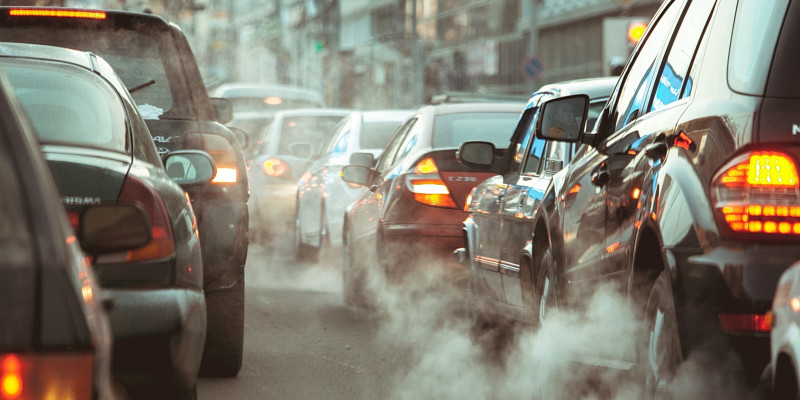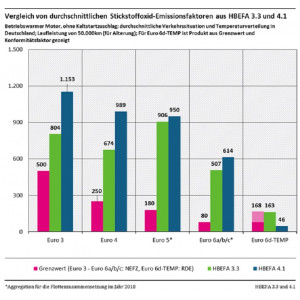The new data is based on the Handbook Emission
Factors for Road Transport (HBEFA 4.1) which was published today. For diesel Euro-6 passenger cars, there is now more data available than for Version 3.3 HBEFA of 2017, with 52 vehicles having been tested in real-life conditions. For all other Euro 3 to 5 vehicles, emissions have now been adjusted to reflect real-world conditions. For example, heavier loads and even more realistic traffic situations have been taken into account. For older model passenger cars and light duty vehicles, HBEFA for the first time now accounts for the correlation between nitrogen oxide emissions and ambient temperature in hot operating conditions. New data also enables taking better account of after-treatment system ageing in the calculations.
Measurements in real-world driving conditions on the road show that the latest Euro 6d-TEMP diesel passenger cars produce considerably less nitrogen oxide emissions – on average 46 milligrams per kilometre (mg NOx/km). This falls short of the new required measurements of real driving emissions (RDE). These new diesel cars currently represent about 5 percent of the diesel passenger car fleet. The new HBEFA certifies that older diesel cars with emission standards up to Euro 6c – comprising the largest proportion of the diesel passenger car fleet – now have even higher RDE than in the past. In the previous version of HBEFA, NOx emissions in real driving conditions for Euro 5 to Euro 6a/b/c diesel cars with engines at operating temperature averaged 906 and 507 mg NOx/km, respectively. In the new version, however, these figures have increased to an average of 950 and 614 mg NOx/km, respectively. The reason for the adjusted figures is also the greater focus on real conditions in the calculation methods. By way of comparison: the compliance requirement for type approval in the laboratory measurement cycle is 180 for Euro 5, and 80 (Euro 6a/b/c) mg NOx/km.
A software update in the two million VW vehicles with an EA 189 series engine which have an installed defeat device became mandatory, a process that is now nearly complete. The measurements taken on eight vehicles indicate that these updates act to reduce NOx emissions in real-world operation by an average of about 25 percent. Post-update emissions average 588 mg/km, or more than three times the laboratory limit values. This is why Euro 5 diesel cars with SRC catalytic converters absolutely must be retrofitted. "The Federal Motor Transport Authority has approved the first retrofit system in recent weeks," said Ms Krautzberger. "These systems must now be installed quickly in those cars. It is manufacturers' responsibility to assume the costs of retrofitting soon and cut the red tape."
The emission factors for carbon dioxide (CO2
) have increased significantly compared to levels in HBEFA 3.3. Real CO2 emissions on the road for new passenger cars have decreased only 8 percent since 2000 (Euro 3), and by a mere 2 percent since 2001 in light duty vehicles (Euro 3). Reasons include ever increasing vehicle mass and performance, combined with the type approval in effect until 2018. "The changes which the EU made in testing procedures and cycles of CO2 emissions in new passenger cars, effective since 1 September 2018, was the right step to take", emphasises Ms Krautzberger. "We must nevertheless keep a close eye on whether these new testing procedures ensure compliance with the regulations on CO2 limit values and that they result in the necessary CO2 emissions cuts in traffic."
Further information
The Handbook Emission Factors for Road Transport (HBEFA) is a database of the specific emissions values for the most common types of passenger car, light and heavy duty vehicle, coaches and motorcycles. HBEFA enables a realistic description of emissions performance in motor vehicles. The newly updated and upgraded HBEFA Version 4.1 and reflects adjusted emission factors. Environmental and transport authorities from Germany, Austria, Switzerland, Norway, France and Sweden provide financial support and are involved in the further development of HBEFA. Version HBEFA 4.1 is available to the public. The installation file is available for a nominal charge of 250 euros from www.hbefa.net/de.
 Click to enlarge
Click to enlarge






修改评论